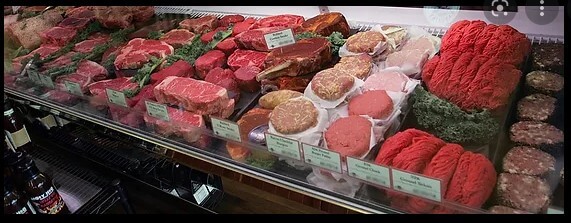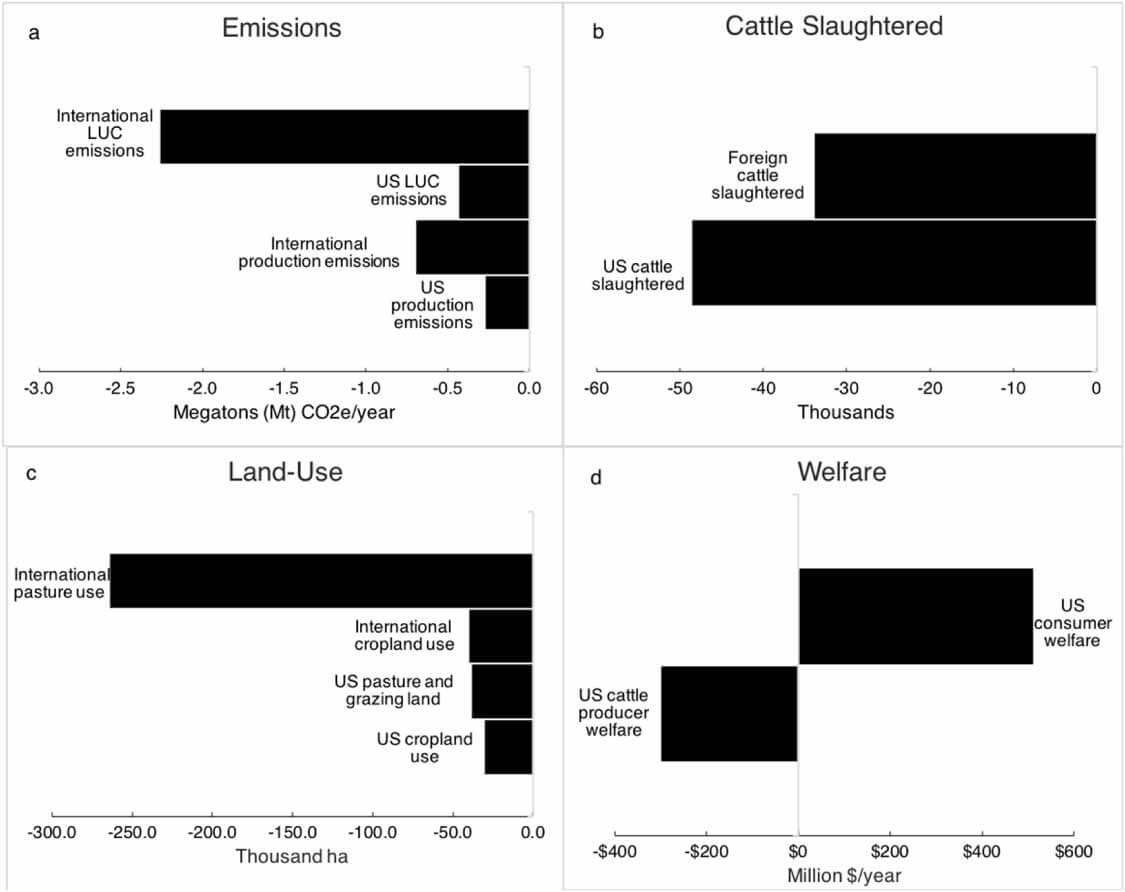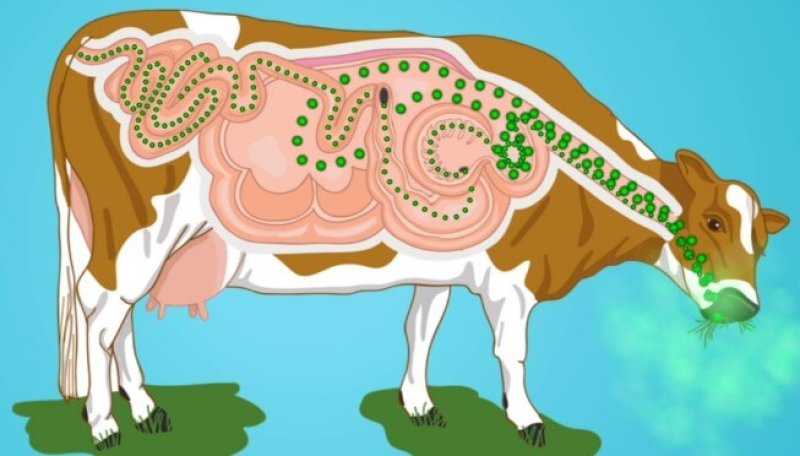…
Increases in U.S. demand for PBM alter trade patterns, leading to a reduction of beef imports and an increase in beef exports, a phenomenon that further reduces global greenhouse gas emissions and land use given the relative efficiency of U.S. beef production. For every 10% reduction in the price of PBM alternatives, we estimate that the global reduction in emissions is equivalent to 0.34% of U.S. emissions from beef production and 1.14% when including reduced land-use change emissions. Even substantial reductions in prices of PBM alternatives are unlikely to have substantive impacts on the U.S. cattle population and emissions, suggesting the need to also pursue alternative mitigation strategies, such as innovations to reduce the methane emissions per head.
1. Introduction
Movement toward more plant-based diets has been estimated to reduce land-use and greenhouse gas emissions, while improving public health relative to a more animal-product-based diet [1–4]. Despite such findings, there is poor compliance with dietary recommendations and many consumers have strong preference for meat in their diets [5, 6]. A potential solution to this problem has emerged as innovations in food science have created novel plant-based meat (PBM) alternatives that approximate the sensory characteristics of animal-sourced meats but are made of plant-based ingredients such as soy, wheat, pea, and novel additive ingredients like heme. Unlike traditional PBMs (i.e. tofu, tempeh, seitan etc.), novel PBMs more closely mimic animal-based meats in terms of their taste and texture [7]. While the macro-nutrient content is broadly similar between novel PBMs and ground beef, there are significant differences in metabolites [8]. Increased production and consumption of novel PBMs, if they reduce livestock production, could reduce environmental impacts, the number of animals slaughtered, and revenue of the livestock industry, which is one of the largest sectors of the agricultural economy [9, 10].
Whether new PBM alternatives can ultimately reduce livestock inventories depends on consumer preferences and relative prices. Novel PBMs are currently priced at a premium to conventional meat alternatives, and it remains unclear how investments in improving efficiency and scale, which would bring down the cost of producing PBM, would affect the future of the beef industry. Moreover, it is unknown how increased promotion and advertising, made possible by significant capital inflows to start-up PBM companies [11], will affect the livestock sector.
Existing studies have found PBMs would create economic opportunities and threats to existing meat producers, but have not estimated the potential magnitude of these impacts or their relation to PBM prices or consumption levels [12]. Given that animal agriculture accounts for more than 40% of all cash income of farmers in the United States [13], and also more than 40% of all greenhouse gas emissions from the sector, these questions are of high societal importance [14].

To determine the impact of changes in consumer demand for PBM or changes in PBM prices on the livestock economy and greenhouse gas emissions, an economic model is constructed linking U.S. cattle production to U.S. beef consumption (the model is fully described in the supplemental information). The impact of PBMs on the beef supply chain is of particular interest given the carbon intensity of beef and the prevalence of plant-based beef burgers and ground beef products.
To accurately portray the impacts of demand-side changes on the number of U.S. cattle, the model captures important nuances of the beef supply chain. U.S. cattle producers supply cattle to packers, who combine cattle with other marketing inputs (labor, packaging, etc) to produce ground beef and non-ground beef products (supplementary figure 1 available online at stacks.iop.org/ERL/17/024035/mmedia). This alone suggests there is not a one-to-one relationship between changes in ground beef demand and the number of cattle because packers can choose to substitute beef for marketing inputs and decide the extent to which whole muscle cuts are converted to ground beef.
The demand-side of the model is calibrated using data from recent studies that have estimated the own- and cross-price elasticity of demand between PBM and ground beef [15]. The model treats the price of PBM as exogenous, which implies that a given percent change in consumer willingness-to-pay for PBM has the same effect in the model as the same percent change in PBM price.
The model also estimates impacts to imports and exports of beef because trade has become an increasingly important component of the U.S. beef supply chain. In 2020, 12.2% of domestic beef consumption was imported from foreign suppliers and 10.8% of domestic production was exported to foreign consumers [16]. U.S. beef production has a lower carbon and land use footprint per unit produced than average production in the rest of the world [17, 18]. This indicates that shifts in beef trade can have environmental impacts.
2. Materials and methods
An equilibrium displacement model of the U.S. beef supply chain, linking supply of U.S. and foreign beef to demand for U.S. beef domestically and abroad, is constructed following general modeling approaches developed in the applied economics literature (supplementary figure 1) [19, 20]. The model consists of a set of inter-linked supply, demand, and identity equations specified as changes relative to an initial equilibrium (supplementary table 1), where endogenous variables (supplementary table 2), consist of prices and quantities of different types of meat, and the primary exogenous variable of interest is the change in the price of PBM, or equivalently a change in consumer demand for PBM.
The model specifies U.S. retail demand for ground beef, non-ground beef, and plant-based alternatives using the elasticity of demand for each good, change in price, and changes in consumer’s willingness-to-pay. Blended products (that mix plant-based and beef ingredients) are not considered in the model as there is currently relatively little market penetration and because of a dearth of research on consumer preferences for these products. The supply of PBM alternatives is assumed to be perfectly elastic, which implies that the changes in the price of PBM are exogenous (supplementary table 3).
Given this, there is no distinction between a change in PBM price or a change in consumer willingness-to-pay for PBM. Beyond Burger cut production costs by approximately 22.22% over a year, while Impossible Foods cut prices for restaurants by 15% in 2020; final retail price reductions for consumers may be lower due to additional marketing and advertising costs of retailers and outlets, so a 10% PBM price reduction is chosen [21].
The total quantity of U.S. ground beef and non-ground beef consists of domestic supplies and imports while the total quantity of U.S. production of ground beef and non-ground beef consists of supply to the domestic market and foreign exports of beef. Domestic supplies of beef are determined by the proportionate change in quantity and price of cattle and marketing inputs and the cost-share attributable to each of these commodities for ground beef and non-ground beef.

Parameters are assigned values for each of the elasticities and share values based on publicly available data on the beef market and estimates in prior literature (supplementary table 4). Of particular note is that an extensive survey of published and unpublished literature is conducted to determine own- and cross-price elasticities of demand for PBM and beef (supplementary table 5). The model is solved for endogenous prices and quantities, and changes in producer and consumer welfare are calculated (supplementary tables 6 and 7).
Changes in domestic and international greenhouse gas (GHG) emissions, cropland, and pasture are calculated by multiplying the model output for cattle quantity by national and global estimates of GHG emissions, cropland use and pasture use per kg carcass weight (supplementary table 8) [3]. Changes in PBM land use and emissions are calculated by multiplying the change in sales, by weight, by the average carbon and land-use intensity of popular plant-based beef products, weighted by market share [22–25]. For the US, change in emissions related to land use is calculated as the potential annual carbon sequestration from reforestation of cropland and suitable pasture made available due to changes in beef production [26].
Substantial reforestation, such as that assumed, would require farmers and ranchers to have sufficient incentive to forgo other potential land uses, such as converting pasture to cropland. Change in international production emissions and land use is calculated by multiplying the change in foreign cattle production by average global production emissions and land use per kg carcass weight, respectively [27]. To estimate international land-use change emissions, the change in land use is multiplied by the average global carbon opportunity cost for beef, estimated using the carbon loss method from Searchinger et al [18]. This approach estimates change in carbon in vegetation, mineral soils, and organic soils due to a reduction in land-use change.
3. Results
The model estimates that cattle production changes by orders of magnitude less than changes in PBM prices. With a 10% decline in PBM price (or 10% increase in consumer willingness-to-pay for PBM), PBM consumption rises approximately 23%, but U.S. beef and cattle prices both fall less than 1%. A 10% PBM price change leads to a 0.15% fall in the number of domestic cattle slaughtered (figure 1), approximately the same impact as a 1% cattle tax, estimated by changing the lambda parameter in the beef cattle supply curve.
The small impact of PBM price changes on U.S. cattle production is mostly due to the share of the total cost of cattle used to produce ground beef, the low elasticity of cattle supply [28], and the cross price elasticity of demand between PBM and ground beef, as demonstrated by linear and non-linear regressions in which the dependent variable is the percent change in cattle quantity resulting from a 10% reduction in PBM prices and the independent variables were six key parameters and their interactions. (supplementary tables 9 and 10). A Monte-Carlo type simulation which drew 5000 values for each of the key parameters found that results declined between 0% and 0.22% in 90% of the simulations (supplementary table 11).

The price and quantity changes increase consumer welfare and reduce cattle producer welfare. These economic welfare measures represent, approximately, the maximum amount of money that consumers, in aggregate, would be willing to pay for the price of PBM to fall by 10%, and the maximum amount of money that, if taken from producers, would make them as bad off as a 10% reduction in PBM price (approximately equal to the change in producer profits). Producer welfare includes the surplus/losses that accrue to all beef producers, packers, and input suppliers to the cattle sector [29]. A 10% decline in PBM price results in a U.S. cattle producer welfare loss of approximately $300 million per year and an increase in consumer welfare of approximately $513 million per year (figure 2(d)).
The change in producer welfare is approximately equal to 0.6% of average 2018–2020 cattle revenue and the change in consumer welfare is about 0.45% of 2018–2020 expenditures on ground and non-ground beef. The producer welfare losses are likely to be most acutely felt by suppliers of cattle (such as dairy cows) that end up in the domestic ground beef market. The welfare measures do not include the value of any environmental improvements that may result from these changes.

Declines in U.S. PBM prices, by shifting patterns of trade, also reduce U.S. and international GHG emissions, land use, and land-use change emissions. With a 10% decline in PBM price, U.S. cropland use, reforestable pasture land use, and GHG emissions from beef and PBM production combined fall by 31 thousand hectares, 39 thousand hectares, and 0.27 megatons (Mt) CO2eq per year, respectively (figures 2(a) and (c)). If reforested, this amount of cropland and pasture could sequester 0.43 Mt CO2 per year. GHG emissions from international production fall more, by 0.70 Mt CO2eq per year, while the reduction in international land-use change results in mitigation of 2.3 Mt CO2 per year, in part, due to the high land-use intensity of global beef production relative to U.S. production. This assumes that reductions in land use result in proportionately less land-use change, which would be expected as global beef demand and agricultural land use continues rising.
To determine the robustness of the results, a sensitivity analysis was conducted for a scenario in which PBM prices fall 10% under different assumptions of key model parameters. All results were qualitatively similar to the baseline model (supplementary table 12). The analysis reveals that the change in total U.S. and foreign cattle slaughtered is most sensitive to the own-price elasticity of cattle supply. When the own-price elasticity of cattle supply increases 25% from 0.25 to 0.3125, as could happen in the longer-run when supply has more time to adjust, the quantity of cattle slaughtered falls by 55 thousand rather than 49 thousand in the baseline model, which is associated with a 10% PBM price reduction. However, losses to producer welfare are less pronounced than in the baseline, as a more elastic supply is representative of a situation where producers are more able to adjust production volumes in response to price changes.
4. Discussion
Despite the lower greenhouse gas impacts associated with PBM, achieving substantively lower aggregate emissions depends on whether consumers are willing to substitute between ground beef, non-ground beef, and PBM. This paper brings to bear data from recent consumer studies providing estimates of these demand inter-relationships in an economic model to trace-back demand-side effects to the farm. Overall, shifts in PBM prices and demand have relatively small effects on the cattle supply chain and have minor environmental and climate benefits.
These outcomes may change in the future as better and more varied PBMs are developed, or as consumer preferences change and these products are seen as more substitutable with beef. At present however, results indicate reductions in price of PBM alone will likely not have a disruptive impact on U.S. cattle production. The impacts may increase as economies of scale further reduce PBM prices. For example, at baseline parameter values, our model indicates that a 20% reduction in PBM prices would result in a 0.29% reduction in the quantity of U.S. cattle produced.
Also, consumer preferences towards PBM vary across different demographics. While certain consumers will be more price responsive than others, the elasticity estimates used are based on the distribution of preferences in the U.S. population and represent market-level responses expected to occur across all consumers from PBM price changes. In addition, despite the small impact on cattle production, PBM price changes have a much greater impact on PBM consumption because the own-price elasticity of demand for PBM is more elastic than that of beef since its market share is much smaller and its retail price higher (supplementary table 5).
While the consumption of ground beef falls as demand for PBM increases, beef exports and domestic non-ground beef also increase. These outcomes highlight the importance of exploring these issues through the lens of an economic model which captures key substitution effects that are not always immediately obvious.
There are several limitations to our analysis. One is that the model utilizes linear approximations to changes in underlying supply and demand relationships, which implies that the relationship between percent changes in PBM prices and percent changes in endogenous prices and quantiles is approximately linear throughout the range of possible PBM price declines. It is plausible, however, that some elasticities could change as prices change [30].
Also, beef is exported to several different locations, so the foreign own-price elasticities of demand for beef could vary by country, but an average of Canada and Mexico values are chosen (supplementary table 4). Varying these parameters by 25% does not substantially alter any results (supplementary table 12). Moreover, the model is an equilibrium displacement model constructed to approximate changes from an initial equilibrium, and is likely to be most accurate for small changes from the initial equilibrium—extrapolations of effects from ‘large’ changes in PBM prices are likely to be associated with greater uncertainty. Whether there are ‘tipping points’ that lead to exponential increases in demand is a matter which is, at present, highly speculative.
In addition, the model does not estimate how changes in US cattle production would affect land use, such as whether land used to grow crops for animal feed could be diverted to produce human food. Instead, the analysis includes an estimate of carbon sequestration if all suitable land previously used for cattle production were reforested. Similarly, the approach used for estimating changes in international emissions, based on the carbon benefits index developed in Searchinger et al does not model changes in specific locations such as in the countries the US exports the most beef to [18]. Yet other commonly used approaches to model land use change, such as global economic models, are not inherently superior as they face substantial challenges in estimating how changes in production in one location affect land use and carbon storage elsewhere [18].
Further studies investigating the impact of PBM price declines in other countries; on different supply chains, such as that of chicken; and using different land use models would be useful avenues of future research. At present, such analysis is hampered by the lack of knowledge of the degree of consumer substitution between PBM and other meat products in the U.S. and other parts of the world.
References
- Shepon A, Eshel G, Noor E and Milo R 2018 The opportunity cost of animal based diets exceeds all food losses Proc. Natl Acad. Sci. 115 3804–9
- Clark M A, Springmann M, Hill J and Tilman D 2019 Multiple health and environmental impacts of foods Proc. Natl Acad. Sci. 116 23357–62
- Eshel G, Shepon A, Makov T and Milo R 2014 Land, irrigation water, greenhouse gas, and reactive nitrogen burdens of meat, eggs, and dairy production in the United States Proc. Natl Acad. Sci. 111 11996–2001
- Heller M C, Willits-Smith A, Meyer R, Keoleian G A and Rose D 2018 Greenhouse gas emissions and energy use associated with production of individual self-selected U.S. diets Environ. Res. Lett. 13 044004
- Heller M C and Keoleian G A 2014 Greenhouse gas emission estimates of U.S. dietary choices and food loss J. Ind. Ecol. 19 391–401
- Lusk J L and Norwood F B 2009 Some economic benefits and costs of vegetarianism Agric. Resour. Econ. Rev. 38 109–24
- Rubio N R, Xiang N and Kaplan D L 2020 Plant-based and cell-based approaches to meat production Nat. Commun. 11 1–11
- van Vliet S, Bain J, Muehlbauer M, Provenza F, Kronberg S, Pieper C and Huffman K 2021 A metabolomics comparison of plant-based meat and grass-fed meat indicates large nutritional differences despite comparable Nutrition Facts panels Sci. Rep. 11 13828
- Santo R E, Kim B F, Goldman S E, Dutkiewicz J, Biehl E M B, Bloem M W, Neff R A and Nachman K E 2020 Considering plant-based meat substitutes and cell-based meats: a public health and food systems perspective Front. Sustain. Food Syst. 4 1–23
- Smetana S, Profeta A, Voigt R, Kircher C and Heinz V 2021 Meat substitution in burgers: nutritional scoring, sensorial testing, and life cycle assessment Future Foods 4 100042
- Choudhury D, Singh S, Seah J S H, Yeo D C L and Tan L P 2020 Commercialization of plant-based meat alternatives Trends Plant Sci. 25 1055–8
- Newton P and Blaustein-Rejto D 2021 Social and economic opportunities and challenges of plant-based and cultured meat for rural producers in the US Front. Sustain. Food Syst. 5 624270
- Economic Research Service 2021 Farm Income and Wealth Statistics available at: www.ers.usda.gov/data-products/farm-income-and-wealth-statistics/data-files-us-and-state-level-farm-income-and-wealth-statistics/(Accesssed June 2021)
- U.S. Environmental Protection Agency 2021 Inventory of U.S. greenhouse gas emissions and sinks: 1990–2019 available at: www.epa.gov/ghgemissions/inventory-us-greenhouse-gas-emissions-and-sinks-1990-2019(Accessed June 2021)
- Van Loo E J, Caputo V and Lusk J L 2020 Consumer preferences for farm-raised meat, lab-grown meat, and plant-based meat alternatives: does information or brand matter? Food Policy 95 101931
- USDA Economics, Statistics, and Market Information System n.d. World Agriculture Supply and Demand Statistics available at: https://downloads.usda.library.cornell.edu/usda-esmis/files/3t945q76s/gf06gv276/ft849g92n/latest.pdf(Accessed January 2021)
- Rotz C A, Asem-Hiablie S, Place S and Thoma G 2019 Environmental footprints of beef cattle production in the United States Agric. Syst. 169 1–13
- Searchinger T D, Wirsenius S, Beringer T and Dumas P 2018 Assessing the efficiency of changes in land use for mitigating climate change Nature 564 249–53
- Wohlgenant M K 2011 The Oxford Handbook of the Economics of Food Consumption and Policy (Oxford: Oxford University Press) Consumer demand and welfare in equilibrium displacement models 292–320
- Alston J M 1991 Research benefits in a multimarket setting: a review Rev. Mark. Agric. Econ. 59 23–52
- Piper K 2021 Impossible Foods’ plant-based meat just got closer to the price of regular meat (Vox) available at: www.vox.com/future-perfect/2021/2/2/22260454/impossible-foods-burger-plant-based-meat(Accessed December 2021)
- Dettling J, Tu Q, Faist M, DelDuce A and Mandlebaum S 2016 A comparative life cycle assessment of plant-based foods and meat foods (Quantis) available at: www.morningstarfarms.com/content/dam/NorthAmerica/morningstarfarms/pdf/MSFPlantBasedLCAReport_2016-04-10_Final.pdf(Accessed December 2021)
- Heller M C and Keoleian G A 2018 Beyond Meat’s beyond burger life cycle assessment: a detailed comparison between a plant-based and an animal-based protein source Center for Sustainable Systems (Ann Arbor: University of Michigan) 1–42 available at: https://css.umich.edu/publication/beyond-meats-beyond-burger-life-cycle-assessment-detailed-comparison-between-plant-based(Accessed December 2021)
- Khan S, Loyala C, Dettling J, Hester J and Moses R 2019 Comparative environmental LCA of the Impossible Burger with conventional ground beef burger (Quantis) available at: https://assets.ctfassets.net/hhv516v5f7sj/4exF7Ex74UoYku640WSF3t/cc213b148ee80fa2d8062e430012ec56/Impossible_foods_comparative_LCA.pdf(Accessed December 2021)
- Hirtzer M, Shanker D and Batista F 2021 America’s biggest meat company gives faux burgers another shot (Bloomberg) available at: www.bloomberg.com/news/articles/2021-05-03/tyson-takes-on-beyond-meat-impossible-foods-with-plant-based-burger-fake-meat(Accessed December 2021)
- Cook-Patton S C et al 2020 Mapping carbon accumulation potential from global natural forest regrowth Nature 585 545–50
- Poore J and Nemecek T 2018 Reducing food’s environmental impacts through producers and consumers Science 360 987–92
- McKendree M G S, Tonsor G T, Schroeder T C and Hendricks N P 2020 Impacts of retail and export demand on United States cattle producers Am. J. Agric. Econ. 102 866–83
- Just R E, Hueth D L and Schmitz A 2005 The Welfare Economics of Public Policy: A Practical Approach to Project and Policy Evaluation (Cheltenham: Edward Elgar Publishing)
- Lusk J L and Tonsor G T 2016 How meat demand elasticities vary with price, income, and product category Appl. Econ. Perspect. Policy 38 673–711
Jayson Lusk is an economist, Distinguished Professor and Department Head in the Department of Agricultural Economics at Purdue University. Find Jayson on Twitter @JaysonLusk
Dan Blaustein-Rejto is a food and agriculture analyst at the Breakthrough Institute. He holds a Master’s in public policy from the University of California Berkeley. Find Dan on Twitter @danrejto
Saloni Shah is a Food and Agriculture Analyst at Breakthrough. Previously, she completed her dual Bachelor’s and Master’s in environmental science and environmental analysis and policy with honors at Boston University. Find Saloni on Twitter @SaloniShah101
Glynn T. Tonsor joined the Kansas State Agricultural Economics faculty as an Assistant Professor in March 2010. He obtained his Ph.D. from K-State in 2006.
A version of this article was originally posted to the Institute of Physics Science and is reposted here with permission. Follow the Institute of Physics on Twitter @IOPscience































